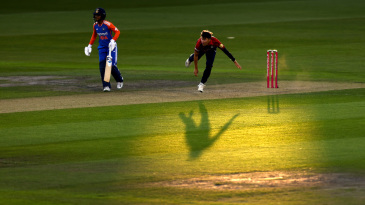Photo feature
Elementary
Cricket and fire, water, wind and earth
Cricket and fire, water, wind and earth
Darren Pateman / © Getty Images

More than any other major sport, cricket is exposed to the four natural elements, even though it cannot be played even under a light drizzle - or so decree international umpires.
Fire
No such problem with flames, it would seem, as club cricketers in Cessnock, New South Wales prove here by continuing their game even as huge bush fires rage by the boundary, 2002.
Neo Ntsoma / © Associated Press

In 2004, a large portion of the Wanderers Club in Johannesburg, first erected in 1944, was destroyed in a fire. The flames could be seen from the nearby Wanderers Stadium, which was hosting a South Africa A-New Zealand A ODI.
Dar Yasin / © Associated Press

Firecrackers are one way to celebrate your team's victory. They are also handy objects to start riotous fires with in the stands.
Ajit Solanki / © Associated Press

Then there's the religious fire: Indian fans pray for their team to win the 2015 World Cup semi-final against Australia. (They did not.)
Hamish Blair / © Getty Images

Sunset in Perth makes the sky look like it has been set ablaze, 2007.
Mary Turner / © Getty Images

A fire extinguisher props up the "wicket" in a game among refugees in Calais. Probably useful for the umpires to keep within reach, especially if heated tempers call for players to be cooled down.
Simon Bruty / © Getty Images

Water
That's another way to cool a player down. Mike Atherton gets doused by a glassful during England A's tour of Zimbabwe, 1990.
© Getty Images

Makhaya Ntini is about to get dunked by Jacques Kallis in Antigua, 2001.
Laurence Griffiths / © Getty Images

Soggy outfield? You can still make a game of it, like Graeme Swann, Andrew Flintoff, Darren Maddy, Matt Windows and Rob Key do in Harare in 1999.
Gemunu Amarasinghe / © Associated Press

But sometimes the outfield is a lake and the best you can do is bail the water out with a bucket. Kandy, 2004.
John Donegan / © Fairfax Media/Getty Images

A 20-overs-a-side match lasts three hours. What about a game of water-bomb cricket? Probably till you or your opponent is soaking wet.
Ray Kennedy / © Fairfax Media/Getty Images

Speaking of soaking wet… Shane Warne tries to ease the pain of a broken toe with some immersion.
Hamish Blair / © Getty Images

Matthew Hayden tries the impossible: attempting to cool off in the 50-degree heat of Sharjah in 2002.
Hagen Hopkins / © Getty Images

Wind
If the covers are carrying the ground staff away, it must be a day (or none) of cricket in Wellington.
© PA Photos

If your umbrella is turned the wrong side out, it must be a wet day of cricket in England.
Matt Dunham / © Associated Press

If Father Time is having a siesta, it must be a particularly breezy day at Lord's.
Gareth Copley / © PA Photos

And if it's a windy day in Kandy, it's like watching cricket sitting in a convertible with the top down.
Will Russell / © Getty Images

Earth
Until cricket in space becomes a viable activity, we'll need the solid ground of our planet to play the game on. But sometimes it's not so solid as these players, examining a crater in the pitch at the WACA in 2013, find.
© PA Photos

When is cricket war? When there are trenches in the outfield. Workmen at Lord's dig to improve drainage at the ground in 1964.
Cameron Spencer / © Getty Images

There's the cricket of the plenty kind: where upturned divots from the grassy outfield can be just chucked away…
Michael Dodge / © Getty Images

… and mud stuck on spikes is a problem.
Christopher Lee / © IDI/Getty Images

And then there's cricket of the kind where grass is at a premium.
Nishi Narayanan is an assistant editor at ESPNcricinfo
© ESPN Sports Media Ltd.


